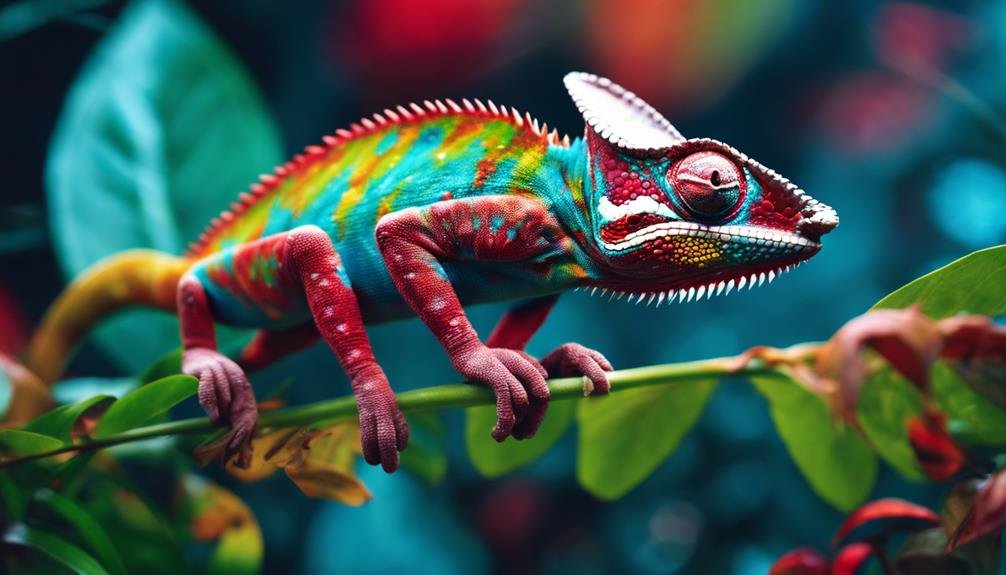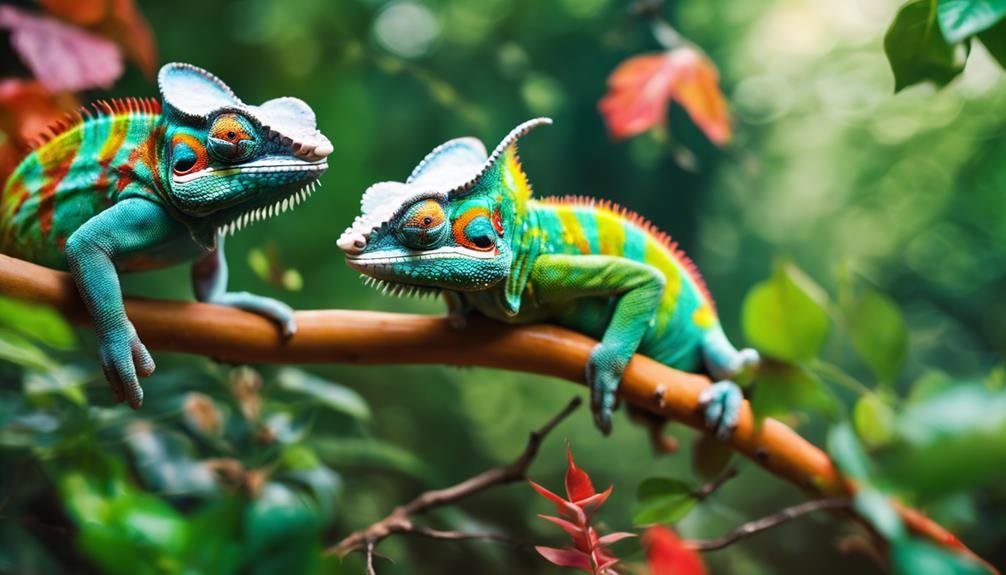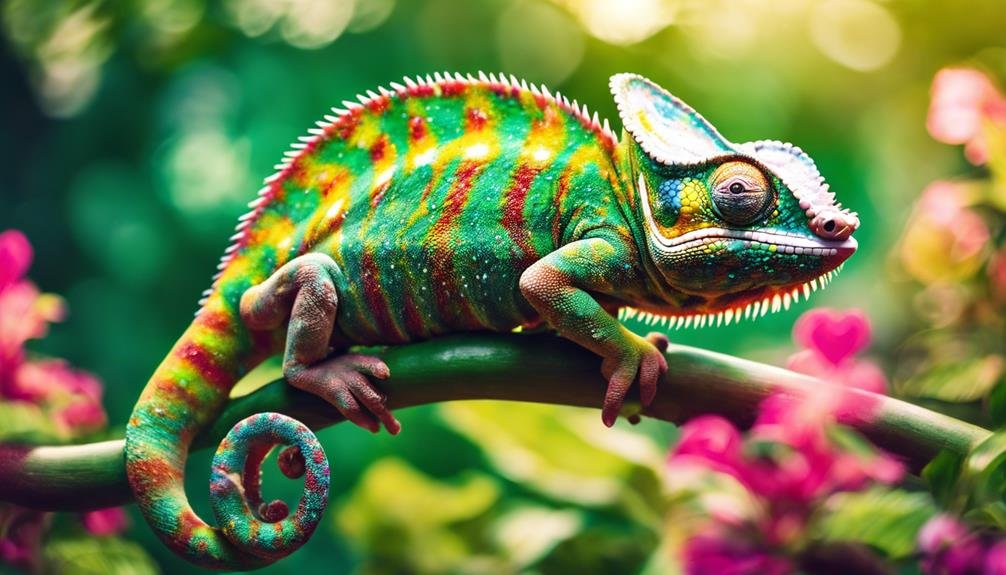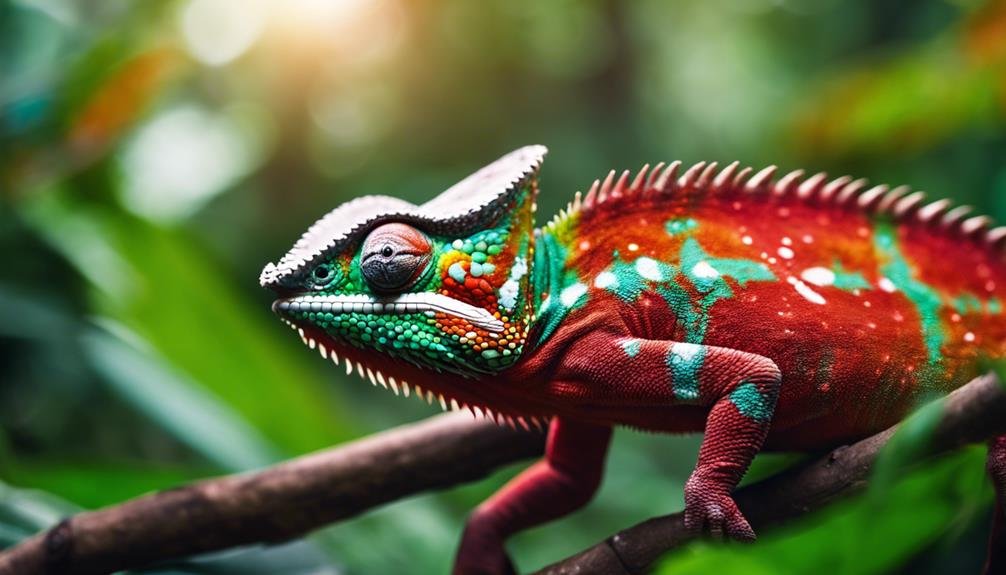You’ve likely seen videos of chameleons shifting their hues, a mesmerizing dance of color that seems almost magical. But have you ever wondered why they undergo such transformations? At its core, this ability isn’t just for show. It’s a sophisticated form of communication and a survival mechanism. Chameleons change their skin color to interact with other chameleons, to better adapt to fluctuating temperatures, and to perfect the art of camouflage. This intricate process, involving active manipulation of specialized cells, serves multiple critical functions in their daily lives and evolutionary success. But how exactly does this process work, and what can it tell us about the intersection of biology and behavior? Let’s explore further.
Key Takeaways
- Chameleons change color to communicate with other chameleons, signaling mood, dominance, or submission.
- Color transformations aid in mating by attracting partners and indicating reproductive readiness.
- They adjust their skin color for camouflage, blending into their environment to evade predators or ambush prey.
- Color changes help regulate their body temperature, adapting to different environmental conditions.
- Bright and vibrant colors can indicate a chameleon’s health and emotional state, such as stress or aggression.
Color Change Mechanisms
Chameleons frequently change color by manipulating specialized cells called chromatophores in their skin. These cells are quite remarkable, housing pigments that range from melanin for darker shades to vibrant blues and yellows. When it’s time for a color change, their nervous system sends signals to these chromatophores. Depending on the signal, the chromatophores either expand or contract, altering the chameleon’s skin color.
You might wonder how this shift happens. It’s all about the combination of pigments. By adjusting which chromatophores expand or contract, chameleons can create an array of colors. For instance, to turn green, they expand both yellow and blue pigment cells. If they need to camouflage or warm up, they might bring forward browns or reds by adjusting the corresponding chromatophores.
This mechanism isn’t just automatic; it’s a sophisticated response to the environment, allowing chameleons to respond dynamically to changes around them. Whether they’re blending into leaves or basking on a sunlit branch, their skin is their secret tool, constantly working through the intricate dance of chromatophores. This isn’t just color change—it’s survival.
Communication Through Colors
Beyond their survival mechanisms, chameleons also use color changes to communicate vividly with one another. These changes aren’t just vital; they’re a sophisticated form of non-verbal communication that plays an important role in their interaction. Imagine you’re a chameleon: flashing different colors and patterns becomes your way to send clear messages to those around you.
For instance, male chameleons often display particularly bold colors when they want to assert dominance or show aggression in social settings. It’s their way of saying ‘back off’ or ‘I’m in charge here’ without making a sound. On the flip side, female chameleons use color change to signal their reproductive status. A particular color pattern might tell a male that she’s ready to mate, serving as an invitation for him to approach.
This communication through colors is essential for maintaining the social dynamics within chameleon communities. These visual signals help chameleons avoid unnecessary conflicts and enhance their interactions during mating seasons. As you watch these creatures, you’re witnessing a complex conversation unfold through the language of colors. Each hue and pattern has its own meaning, contributing to the rich tapestry of chameleon social signals.
Mood Expression and Colors


Reflecting their inner states, chameleons utilize color changes to express moods ranging from aggression to submission. When you see a chameleon flaunting bright red and yellow hues, it’s showcasing its excitement or asserting its strength. Conversely, duller shades often signal that the chameleon feels weak or submissive, particularly in males. These visual cues are important as they play an essential role in their social behavior, letting other chameleons gauge who’s feeling bold or bashful without a skirmish.
The speed and intensity of these color transformations are more than just a spectacle; they’re predictive tools. Observing how quickly a chameleon changes its colors can help you anticipate the outcome of its social interactions. Will it be a peaceful encounter, or is there trouble brewing? This aspect of mood expression through colors not only fascinates herpetologists but also provides anyone watching with insights into chameleon social dynamics.
Understanding this color-coded system of mood expression enhances your appreciation of how chameleons communicate. It’s not just about survival; it’s about interaction. Each shade shift is a word in their visual vocabulary, a sentence in their ongoing dialogue with the world around them.
Dominance and Aggression Signals
When a male chameleon flashes vibrant red and yellow, it’s asserting dominance and signaling aggression in territorial disputes. These bright colors aren’t just for show; they’re pivotal dominance signals that communicate strength and readiness to defend territory. This non-verbal communication is essential in the wild, where visual cues often dictate interactions.
As you observe these colorful displays, it’s evident that color changes serve as a powerful tool in chameleon conflicts. The brighter and quicker the change, the more likely a chameleon is to dominate its rival. This isn’t just about looking impressive—it’s a clear indicator of vigor and combat readiness. Duller colors, on the other hand, can signal weakness, making those chameleons less likely to succeed in asserting their dominance.
These color transformations are a sophisticated form of aggression display, essential for maintaining social hierarchy among chameleons. They prevent physical confrontations by allowing individuals to assess each other’s strength non-verbally. Understanding this aspect of chameleon behavior highlights the complexity of their interactions and the critical role that visual signals play in their survival and social organization.
Mating and Reproductive Cues


Male chameleons signal their readiness to mate by shifting their colors to more vibrant hues, while females may change coloration to show they’re open to mating advances. During these mating rituals, the importance and complexity of their colors play vital roles. You’ll notice that vibrant and striking colors aren’t just for show; they’re integral to the courtship behaviors and reproductive interactions of chameleons.
Here’s how color changes facilitate these interactions:
- Dominance Display: Males exhibit brighter and more varied colors to assert dominance over rivals, making them more appealing to potential mates.
- Attraction Mechanism: Females use subtle color shifts to signal their receptiveness, attracting the attention of males.
- Communication of Intent: Specific patterns can indicate a readiness to mate or a warning to back off to other chameleons.
- Enhancement of Visual Signals: During courtship, enhanced coloration helps maintain visual interest and engagement between potential mates.
- Reproductive Status: Colors and patterns can indicate health and reproductive quality, influencing mate choice.
As these color changes occur, they’re not just random; they’re strategic, enhancing the chameleon’s ability to successfully engage in reproductive interactions and secure the continuation of their species.
Temperature Regulation
To regulate their body temperature, chameleons change color, either absorbing or reflecting sunlight depending on their needs. This fascinating process involves the expansion or contraction of specialized skin cells, known as chromatophores. These cells contain pigments that either darken or lighten the skin color, playing a key role in temperature regulation.
When it’s cool, you’ll notice chameleons turning darker. This darker skin color is due to the expansion of the chromatophores, which allows them to absorb more sunlight and consequently, heat up quicker. It’s an efficient way to elevate their body temperature, ensuring their metabolic functions continue to run smoothly despite cooler external conditions.
Conversely, in hotter environments, chameleons adopt lighter colors to reflect heat away from their bodies. By contracting their specialized cells, they reduce the pigmentation in their skin, thus preventing overheating. This ability to reflect sunlight rather than absorb it helps maintain their ideal body temperature, ensuring they don’t overheat.
This clever use of skin color for thermal regulation showcases just how adaptive chameleons are to their environments, using their color-changing ability not just for camouflage or communication, but also to survive and thrive in varying temperatures.
Do Chameleons and Bearded Dragons Have Similar Color-Changing Abilities?
Chameleons and bearded dragons have different color-changing abilities. Chameleons change color for camouflage and communication, while bearded dragons don’t change color for those reasons. Instead, they change color based on their mood, temperature, or to blend in with their surroundings, such as the desert where bearded dragons live.
Species-Specific Color Patterns


Among various chameleon species, each exhibits unique color patterns that are essential for species recognition and effective communication. These species-specific color patterns aren’t just random; they’re evolutionary adaptations that play an essential role in their survival and interaction within their environments.
For example:
- Panther chameleons are known for their vivid displays of blue, red, green, yellow, and orange, making them easily distinguishable.
- Veiled chameleons, though less colorful, have a prominent casque on their head that aids in species recognition.
- Jackson’s chameleons shift from brown to vibrant greens, teals, blacks, and yellows as they mature, reflecting their growth stages and species identity.
- Each species adapts its coloration to blend into its specific habitat, aiding in camouflage and predator evasion.
- The distinct color patterns also facilitate complex social interactions and mating behaviors within species.
These visual signals are vital for you to understand how chameleons communicate with each other and navigate their world. It’s fascinating to observe how each species has honed its appearance over generations, tailoring their colors specifically for their ecological niche and social structure.
Conclusion
You’ve seen how chameleons aren’t just about stealth; their color changes are a dynamic language. They communicate, show their mood, and even control their body heat this way.
Whether it’s to intimidate rivals, attract a mate, or simply stay comfortable, each shade shift is a crucial part of their survival.
So, next time you spot a chameleon shifting colors, remember, it’s not just camouflage—it’s a glimpse into their complex social and biological world.


